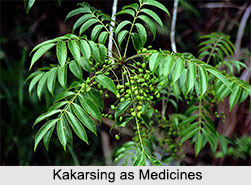 The horn-like excrescences caused by insects on the branches of Rhus Succedanea are called "Kakarsing" or "Karkatasringi". They are large, hollow, thin-walled, generally cylindrical, tapering to either extremity. They are considered tonic, expectorant and useful in cough, phthisis, asthma, fever, want of appetite and irritability of stomach.
The horn-like excrescences caused by insects on the branches of Rhus Succedanea are called "Kakarsing" or "Karkatasringi". They are large, hollow, thin-walled, generally cylindrical, tapering to either extremity. They are considered tonic, expectorant and useful in cough, phthisis, asthma, fever, want of appetite and irritability of stomach.
Dose of Kakarsing in Medicine
Dose should be about 20 grains. This medicine is much used in cough, in combination with other drugs for the disease. The following is the composition; take karkatasringi, root of Clerodendron Siphonanthus (brahmayashti), raisins, ginger, long pepper and Curcuma Zedoaria (sati) in equal parts, powder it and mix.
Dose should be about 30 grains with treacle or honey, in dry cough. In catarrhal fever with difficult breathing a powder composed of equal parts of karkatasringi, bark of Myrica sapida (katphala), and long pepper is recommended to be given in doses of about a drachm with honey. The following called "Sringyadi churna" is much esteemed as a cough linctus for children. Take karkatasringi, atis and long pepper in equal parts; powder it and make into a linctus with honey.
This article is a stub. You can enrich by adding more information to it. Send your Write Up to content@indianetzone.com
Related Articles
Ayurveda
Origin of Ayurveda
Ayurveda Medication
Elements of Ayurveda
Concepts of Ayurveda
Sushruta Samhita
Classification of Medicine




















